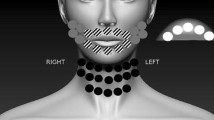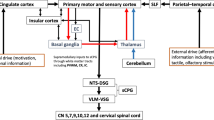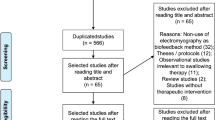Abstract
The purpose of this systematic review was to examine the application of event-related potentials (ERPs) to investigate neural processes of swallowing functions in adults with and without dysphagia. Computerized literature searches were performed from three search engines. Studies were screened using Covidence (Cochrane tool) and followed the Preferred Reporting Items for Systematic Reviews and Meta-Analyses statement standards (PRISMA-2009). A total of 759 studies were initially retrieved, of which 12 studies met inclusion criteria. Electrophysiological measures assessing swallowing functions were identified in two major ERP categories: (1) sensory potentials and (2) pre-motor potentials. Approximately 80% of eligible studies demonstrated strong methodological quality, although most employed a case series or case–control study design. Pharyngeal sensory-evoked potentials (PSEPs) were used to assess pharyngeal afferent cortical processing. The temporal sequence of the PSEP waveforms varied based on the sensory stimuli. PSEPs were delayed with localized scalp maps in patients with dysphagia as compared to healthy controls. The pre-motor ERPs assessed the cortical substrates involved in motor planning for swallowing, with the following major neural substrates identified: pre-motor cortex, supplementary motor area, and primary sensorimotor cortex. The pre-motor ERPs differed in amplitude for the swallow task (saliva versus liquid swallow), and the neural networks differed for cued versus non-cued task of swallowing suggesting differences in cognitive processes. This systematic review describes the application of electrophysiological measures to assess swallowing function and the promising application for furthering understanding of the neural substrates of swallowing. Standardization of protocols for use of electrophysiological measures to examine swallowing would allow for aggregation of study data to inform clinical practice for dysphagia rehabilitation.



Similar content being viewed by others
References
Martino R, Foley N, Bhogal S, Diamant N, Speechley M, Teasell R. Dysphagia after stroke: incidence, diagnosis, and pulmonary complications. Stroke. 2005;36:2756–63.
Kalf JG, de Swart BJM, Bloem BR, Munneke M. Prevalence of oropharyngeal dysphagia in Parkinson’s disease: a meta-analysis. Parkinsonism Relat Disord. 2012;18:311–5.
Hutcheson KA, Nurgalieva Z, Zhao H, Gunn GB, Giordano SH, Bhayani MK, et al. Two-year prevalence of dysphagia and related outcomes in head and neck cancer survivors: an updated SEER-medicare analysis. Head Neck. 2019;41:479–87.
Attrill S, White S, Murray J, Hammond S, Doeltgen S. Impact of oropharyngeal dysphagia on healthcare cost and length of stay in hospital: a systematic review. BMC Health Serv Res. 2018;18:594.
Allen J, Greene M, Sabido I, Stretton M, Miles A. Economic costs of dysphagia among hospitalized patients. Laryngoscope. 2020;130:974–9.
Patel DA, Krishnaswami S, Steger E, Conover E, Vaezi MF, Ciucci MR, et al. Economic and survival burden of dysphagia among inpatients in the United States. Dis Esophagus Off J Int Soc Dis Esophagus. 2018;31:1–7.
Sörös P, Inamoto Y, Martin RE. Functional brain imaging of swallowing: an activation likelihood estimation meta-analysis. Hum Brain Mapp. 2009;30:2426–39.
Malandraki GA, Johnson S, Robbins J. Functional magnetic resonance imaging of swallowing function: from neurophysiology to neuroplasticity. Head & Neck. 2011;33:S14-20.
Loose R, Hamdy S, Enck P. Magnetoencephalographic response characteristics associated with tongue movement. Dysphagia. 2001;16:183–5.
Michou E, Raginis-Zborowska A, Watanabe M, Lodhi T, Hamdy S. Repetitive transcranial magnetic stimulation: a novel approach for treating oropharyngeal dysphagia. Curr Gastroenterol Rep. 2016;18:10.
Michou E, Hamdy S. Cortical input in control of swallowing. Curr Opin Otolaryngol Head Neck Surg. 2009;17:166–71.
Maezawa H. Cortical mechanisms of tongue sensorimotor functions in humans: a review of the magnetoencephalography approach. Front Hum Neurosci. 2017;11:134.
Furlong PL, Hobson AR, Aziz Q, Barnes GR, Singh KD, Hillebrand A, et al. Dissociating the spatio-temporal characteristics of cortical neuronal activity associated with human volitional swallowing in the healthy adult brain. Neuroimage. 2004;22:1447–55.
Lowell SY, Poletto CJ, Knorr-Chung BR, Reynolds RC, Simonyan K, Ludlow CL. Sensory stimulation activates both motor and sensory components of the swallowing system. Neuroimage. 2008;42:285–95.
Martin RE, Goodyear BG, Gati JS, Menon RS. Cerebral cortical representation of automatic and volitional swallowing in humans. J Neurophysiol. 2001;85:938–50.
Jestrović I, Coyle JL, Sejdić E. Decoding human swallowing via electroencephalography a state-of-the-art review. J Neural Eng. 2015;12:051001.
Luck SJ. An introduction to the event-related potential technique. 2nd ed. Cambridge, MA, USA: A Bradford Book; 2014.
Woodman GF. A brief introduction to the use of event-related potentials (ERPs) in studies of perception and attention. Atten Percept Psychophys. 2010;72(8):2031–46.
Handy TC. Event-related potentials: A methods handbook. Cambridge: MIT Press; 2005.
Chan P-YS, Davenport PW. Respiratory-related evoked potential measures of respiratory sensory gating. J Appl Physiol. 2008;105:1106–13.
Fujiu M, Toleikis JR, Logemann JA, Larson CR. Glossopharyngeal evoked potentials in normal subjects following mechanical stimulation of the anterior faucial pillar. Electroencephalogr Clin Neurophysiol. 1994;92:183–95.
Huckabee M-L, Deecke L, Cannito MP, Gould HJ, Mayr W. Cortical control mechanisms in volitional swallowing: the bereitschaftspotential. Brain Topogr. 2003;16(1):3–17.
Satow T, Ikeda A, Yamamoto J, Begum T, Thuy DHD, Matsuhashi M, et al. Role of primary sensorimotor cortex and supplementary motor area in volitional swallowing: a movement-related cortical potential study. Am J Physiol-Gastrointest Liver Physiol. 2004;287:G459–70.
Hiraoka K. Movement-related cortical potentials associated with saliva and water bolus swallowing. Dysphagia. 2004;19(3):155–9.
Nonaka T, Yoshida M, Yamaguchi T, Uchida A, Ohba H, Oka S, et al. Contingent negative variations associated with command swallowing in humans. Clin Neurophysiol. 2009;120:1845–51.
Wheeler-Hegland K, Pitts T, Davenport PW. Peak morphology and scalp topography of the pharyngeal sensory-evoked potential. Dysphagia. 2011;26:287–94.
Wheeler-Hegland K, Pitts T, Davenport PW. Cortical gating of oropharyngeal sensory stimuli. Front Physiol. 2011;1:167.
Pitts T, Hegland KW, Sapienza CM, Bolser DC, Davenport PW. Alterations in oropharyngeal sensory evoked potentials (PSEP) with Parkinson’s disease. Respir Physiol Neurobiol. 2016;229:11–6.
Rofes L, Ortega O, Vilardell N, Mundet L, Clavé P. Spatiotemporal characteristics of the pharyngeal event-related potential in healthy subjects and older patients with oropharyngeal dysfunction. Neurogastroenterol Motil. 2017;29:e12916.
Cabib C, Ortega O, Vilardell N, Mundet L, Clavé P, Rofes L. Chronic post-stroke oropharyngeal dysphagia is associated with impaired cortical activation to pharyngeal sensory inputs. Eur J Neurol. 2017;24:1355–62.
Tomsen N, Ortega O, Rofes L, Arreola V, Martin A, Mundet L, et al. Acute and subacute effects of oropharyngeal sensory stimulation with TRPV1 agonists in older patients with oropharyngeal dysphagia: a biomechanical and neurophysiological randomized pilot study. Ther Adv Gastroenterol. 2019;12:1756284819842043.
Tomsen N, Alvarez-Berdugo D, Rofes L, Ortega O, Arreola V, Nascimento W, et al. A randomized clinical trial on the acute therapeutic effect of TRPA1 and TRPM8 agonists in patients with oropharyngeal dysphagia. Neurogastroenterol Motil. 2020;32:e13821.
Shibasaki H, Hallett M. What is the bereitschaftspotential? Clin Neurophysiol. 2006;117:2341–56.
Deecke L. Planning, preparation, execution, and imagery of volitional action. Cogn Brain Res. 1996;3:59–64.
Walter WG, Cooper R, Aldridge VJ, Mccallum WC, Winter AL. Contingent negative variation: an electric sign of sensori-motor association and expectancy in the human brain. Nature. 1964;203:380–4.
Rektor I, Bareš M, Brázdil M, Kaňovský P, Rektorová I, Sochǔrková D, et al. Cognitive- and movement-related potentials recorded in the human basal ganglia. Mov Disord. 2005;20:562–8.
Brunner JF, Olsen A, Aasen IE, Løhaugen GC, Håberg AK, Kropotov J. Neuropsychological parameters indexing executive processes are associated with independent components of ERPs. Neuropsychologia. 2015;66:144–56.
Taylor BK, Gavin WJ, Davies PL. The test-retest reliability of the visually-evoked contingent negative variation (CNV) in children and adults. Dev Neuropsychol. 2016;41:162–75.
Page MJ, McKenzie JE, Bossuyt PM, Boutron I, Hoffmann TC, Mulrow CD, et al. The PRISMA 2020 statement: an updated guideline for reporting systematic reviews. BMJ British Medical Journal Publishing Group. 2021;372:n71.
Howick J, Phillips B, Ball C, Sackett D, Badenoch D, Straus S, et al. Oxford centre for evidence-based medicine levels of evidence. 2009. http://www.cebm.net/oxford-centre-evidence-based-medicine-levels-evidence-march-2009/.
Kmet LM, Lee RC, Cook LS. Standard quality assessment criteria for evaluating primary research papers from a variety of fields. Alberta Her Found Med Res. 2004. https://www.crd.york.ac.uk/CRDWeb/ShowRecord.asp?ID=32004000313&ID=32004000313
Rofes L, Arreola V, López I, Martin A, Sebastián M, Ciurana A, et al. Effect of surface sensory and motor electrical stimulation on chronic poststroke oropharyngeal dysfunction. Neurogastroenterol Motil. 2013;25:888-e701.
Cabib C, Nascimento W, Rofes L, Arreola V, Tomsen N, Mundet L, et al. Neurophysiological and biomechanical evaluation of the mechanisms which impair safety of swallow in chronic post-stroke patients. Transl Stroke Res. 2020;11:16–28.
Magara J, Watanabe M, Tsujimura T, Hamdy S, Inoue M. Lasting modulation of human cortical swallowing motor pathways following thermal tongue stimulation. Neurogastroenterol Motil. 2021;33:3938.
Hamdy S. Role of cerebral cortex in the control of swallowing. GI Motil Online [Internet]. 2006.
Wilmskoetter J, Daniels SK, Miller AJ. Cortical and subcortical control of swallowing—can we use information from lesion locations to improve diagnosis and treatment for patients with stroke? Am J Speech Lang Pathol. 2020;29:1030–43.
Humbert IA, Robbins J. Normal swallowing and functional magnetic resonance imaging: a systematic review. Dysphagia. 2007;22:266–75.
Woodman GF. A brief introduction to the use of event-related potentials in studies of perception and attention. Atten Percept Psychophys. 2010;72:2031–46.
von Leupoldt A, Keil A, Chan P-YS, Bradley MM, Lang PJ, Davenport PW. Cortical sources of the respiratory-related evoked potential. Respir Physiol Neurobiol. 2010;170:198–201.
Chan P-YS, Davenport PW. Respiratory related evoked potential measures of cerebral cortical respiratory information processing. Biol Psychol. 2010;84:4–12.
von Leupoldt A, Keil A, Davenport PW. Respiratory-related evoked potential measurements using high-density electroencephalography. Clin Neurophysiol. 2011;122:815–8.
Cabib C, Ortega O, Kumru H, Palomeras E, Vilardell N, Alvarez-Berdugo D, et al. Neurorehabilitation strategies for poststroke oropharyngeal dysphagia: from compensation to the recovery of swallowing function. Ann N Y Acad Sci. 2016;1380:121–38.
Cuellar M, Harkrider AW, Jenson D, Thornton D, Bowers A, Saltuklaroglu T. Time–frequency analysis of the EEG mu rhythm as a measure of sensorimotor integration in the later stages of swallowing. Clin Neurophysiol. 2016;127:2625–35.
Jestrović I, Coyle JL, Sejdić E. Characterizing functional connectivity patterns during saliva swallows in different head positions. J NeuroEng Rehabil. 2015;12:61.
Yang H, Guan C, Chua KSG, Chok SS, Wang CC, Soon PK, et al. Detection of motor imagery of swallow EEG signals based on the dual-tree complex wavelet transform and adaptive model selection. J Neural Eng. 2014;11:035016.
Jestrović I, Coyle JL, Sejdić E. Differences in brain networks during consecutive swallows detected using an optimized vertex-frequency algorithm. Neuroscience. 2017;344:113–23.
Jestrović I, Coyle JL, Perera S, Sejdić E. Influence of attention and bolus volume on brain organization during swallowing. Brain Struct Funct. 2018;223:955–64.
Funding
None.
Author information
Authors and Affiliations
Corresponding author
Ethics declarations
Conflict of interest
The authors have no conflicts of interest to report for this manuscript.
Additional information
Publisher's Note
Springer Nature remains neutral with regard to jurisdictional claims in published maps and institutional affiliations.
Rights and permissions
About this article
Cite this article
Bhutada, A.M., Davis, T.M. & Garand, K.L. Electrophysiological Measures of Swallowing Functions: A Systematic Review. Dysphagia 37, 1633–1650 (2022). https://doi.org/10.1007/s00455-022-10426-4
Received:
Accepted:
Published:
Issue Date:
DOI: https://doi.org/10.1007/s00455-022-10426-4




